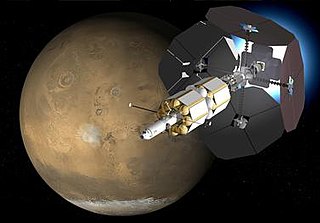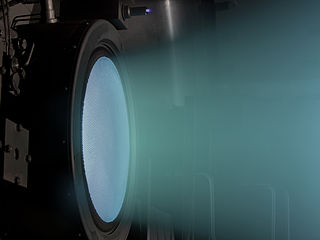
Deep Space 1 (DS1) was a NASA technology demonstration spacecraft which flew by an asteroid and a comet. It was part of the New Millennium Program, dedicated to testing advanced technologies.

Spacecraft propulsion is any method used to accelerate spacecraft and artificial satellites. In-space propulsion exclusively deals with propulsion systems used in the vacuum of space and should not be confused with space launch or atmospheric entry.

In spacecraft propulsion, a Hall-effect thruster (HET) is a type of ion thruster in which the propellant is accelerated by an electric field. Hall-effect thrusters are sometimes referred to as Hall thrusters or Hall-current thrusters. Hall-effect thrusters use a magnetic field to limit the electrons' axial motion and then use them to ionize propellant, efficiently accelerate the ions to produce thrust, and neutralize the ions in the plume. The Hall-effect thruster is classed as a moderate specific impulse space propulsion technology and has benefited from considerable theoretical and experimental research since the 1960s.

An ion thruster, ion drive, or ion engine is a form of electric propulsion used for spacecraft propulsion. It creates thrust by accelerating ions using electricity.

A magnetoplasmadynamic (MPD) thruster (MPDT) is a form of electrically powered spacecraft propulsion which uses the Lorentz force to generate thrust. It is sometimes referred to as Lorentz Force Accelerator (LFA) or MPD arcjet.
A nuclear electric rocket is a type of spacecraft propulsion system where thermal energy from a nuclear reactor is converted to electrical energy, which is used to drive an ion thruster or other electrical spacecraft propulsion technology. The nuclear electric rocket terminology is slightly inconsistent, as technically the "rocket" part of the propulsion system is non-nuclear and could also be driven by solar panels. This is in contrast with a nuclear thermal rocket, which directly uses reactor heat to add energy to a working fluid, which is then expelled out of a rocket nozzle.

The Variable Specific Impulse Magnetoplasma Rocket (VASIMR) is an electrothermal thruster under development for possible use in spacecraft propulsion. It uses radio waves to ionize and heat an inert propellant, forming a plasma, then a magnetic field to confine and accelerate the expanding plasma, generating thrust. It is a plasma propulsion engine, one of several types of spacecraft electric propulsion systems.

SMART-1 was a Swedish-designed European Space Agency satellite that orbited the Moon. It was launched on 27 September 2003 at 23:14 UTC from the Guiana Space Centre in Kourou, French Guiana. "SMART-1" stands for Small Missions for Advanced Research in Technology-1. On 3 September 2006, SMART-1 was deliberately crashed into the Moon's surface, ending its mission.

The Jupiter Icy Moons Orbiter (JIMO) was a proposed NASA spacecraft designed to explore the icy moons of Jupiter. The main target was Europa, where an ocean of liquid water may harbor alien life. Ganymede and Callisto, which are now thought to also have liquid, salty oceans beneath their icy surfaces, were also targets of interest for the probe.

Dawn is a retired space probe that was launched by NASA in September 2007 with the mission of studying two of the three known protoplanets of the asteroid belt: Vesta and Ceres. In the fulfillment of that mission—the ninth in NASA's Discovery Program—Dawn entered orbit around Vesta on July 16, 2011, and completed a 14-month survey mission before leaving for Ceres in late 2012. It entered orbit around Ceres on March 6, 2015. In 2017, NASA announced that the planned nine-year mission would be extended until the probe's hydrazine fuel supply was depleted. On November 1, 2018, NASA announced that Dawn had depleted its hydrazine, and the mission was ended. The derelict probe remains in a stable orbit around Ceres.

Solar electric propulsion (SEP) refers to the combination of solar cells and electric thrusters to propel a spacecraft through outer space. This technology has been exploited in a variety of spacecraft designs by the European Space Agency (ESA), the JAXA, Indian Space Research Organisation (ISRO) and NASA. SEP has a significantly higher specific impulse than chemical rocket propulsion, thus requiring less propellant mass to be launched with a spacecraft. The technology has been evaluated for missions to Mars.

The gridded ion thruster is a common design for ion thrusters, a highly efficient low-thrust spacecraft propulsion method running on electrical power by using high-voltage grid electrodes to accelerate ions with electrostatic forces.

A plasma propulsion engine is a type of electric propulsion that generates thrust from a quasi-neutral plasma. This is in contrast with ion thruster engines, which generate thrust through extracting an ion current from the plasma source, which is then accelerated to high velocities using grids/anodes. These exist in many forms. However, in the scientific literature, the term "plasma thruster" sometimes encompasses thrusters usually designated as "ion engines".

Spacecraft electric propulsion is a type of spacecraft propulsion technique that uses electrostatic or electromagnetic fields to accelerate mass to high speed and thus generate thrust to modify the velocity of a spacecraft in orbit. The propulsion system is controlled by power electronics.

TAU was a proposed uncrewed interstellar probe that would go to a distance of one thousand astronomical units from the Earth and Sun by the NASA Jet Propulsion Laboratory in 1987 using tested technology. One scientific purpose would be to measure the distance to other stars via stellar parallax. Studies continued into 1990, working with a launch in the 2005–2010 timeframe.

SERT-1 was a NASA probe used to test electrostatic ion thruster design and was built by NASA's Lewis Research Center. SERT-1 was the first spacecraft to utilize ion engine design. It was launched on July 20, 1964 on a Scout rocket. It carried two electric propulsion engines; of the two, the first, an electron-bombardment ion engine was run for a total of 31 minutes and 16 seconds. This was the first time that an ion engine of any type had been operated in space, and demonstrated that the neutralizer worked as predicted.
The Dual-Stage 4-Grid (DS4G) is an electrostatic ion thruster design developed by the European Space Agency, in collaboration with the Australian National University. The design was derived by D. Fern from Controlled Thermonuclear Reactor experiments that use a 4-grid mechanism to accelerate ion beams.

The NASA Evolutionary Xenon Thruster (NEXT) project at Glenn Research Center is a gridded electrostatic ion thruster about three times as powerful as the NSTAR used on Dawn and Deep Space 1 spacecraft. It was used in DART, launched in 2021.

The Asteroid Redirect Mission (ARM), also known as the Asteroid Retrieval and Utilization (ARU) mission and the Asteroid Initiative, was a space mission proposed by NASA in 2013; the mission was later cancelled. The Asteroid Retrieval Robotic Mission (ARRM) spacecraft would rendezvous with a large near-Earth asteroid and use robotic arms with anchoring grippers to retrieve a 4-meter boulder from the asteroid.

Advanced Electric Propulsion System (AEPS) is a solar electric propulsion system for spacecraft that is being designed, developed and tested by NASA and Aerojet Rocketdyne for large-scale science missions and cargo transportation. The first application of the AEPS is to propel the Power and Propulsion Element (PPE) of Gateway, to be launched in 2024. The PPE module is built by Maxar space solutions in Palo Alto, California. Two identical AEPS engines would consume 25 kW being generated by the roll-out solar array (ROSA) assembly, which can produce over 60 kW of power.
















